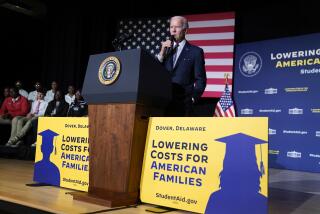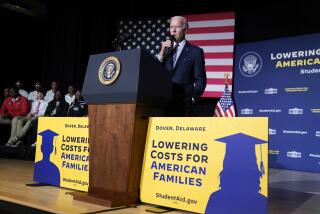College credit that fails students
For four months this year, while Congress was overhauling student loan laws, I traveled the country in a beat-up RV meeting with citizens and legislators. My mission was simple: Persuade Congress to restore consumer protections to student loan borrowers. After 22,000 miles, 42 states and five flat tires, I can’t help but feel that my efforts were a waste of time. And gas.
Sure, the House and Senate passed HR 2669, the College Cost Reduction Act. After reconciliation, it will soon be on its way to the president’s desk. The bill includes some attractive provisions for those headed back to campus this fall, including interest rate reductions, loan forgiveness for public service, Pell grant increases and income-contingent repayment plans for future graduates. But it doesn’t fix a fundamental problem: Basic consumer protections were stripped from student loans in the mid-1990s. This act does nothing to bring them back.
Reacting to much-publicized stories of student-borrower bankruptcies and a default rate of 22% in the late 1970s, Congress mandated seven years of repayment before borrowers could declare bankruptcy on federal student loans. In 1998 -- under an extremely business-friendly Congress -- this qualifier was done away with, rendering all federal student loans non-dischargeable except in the most dire circumstances, such as total and permanent disability.
Big lenders, such as Sallie Mae, even persuaded Congress to remove bankruptcy protections for private loans in 2005 -- these are the nongovernmental loans we’ve been hearing about lately, whose interest rates can exceed 18%. Credit card companies and payday lenders could only dream of this kind of congressional giveaway.
Congress also took away the freedom of borrowers to shop their student loans around in a competitive marketplace. Many college students graduate with two or three types of student loans and choose to consolidate them either to simplify repayment or to pay them back over more time. But once they’ve consolidated, borrowers become captive to that one loan company. They can never refinance again, no matter how interest rates fluctuate or how badly their lenders treat them.
But this is only the tip of the iceberg: Sallie Mae and other student loan interests also had lobbied heavily for legislation that took away other standard consumer protections, including adherence to the Fair Debt Collection Practices Act (student loan companies were specifically exempted in 1996), and statutes of limitations (removed for student loans in 1999). Student loans were also exempted from “truth in lending” regulations, the rules that require lenders to point out key information -- annual percentage rate and fees -- to borrowers on all loan documents.
Congress also let lenders levy massive fees -- often as high as 25% of the balance of the loan -- on those having trouble making payments. Student loan companies got draconian collection powers, including the right to garnish a borrower’s wages, tax refunds and Social Security or disability payments. Some states even got into the act, suspending professional licenses of student borrowers in default. No other lender has these kind of powers -- not credit card companies, not payday lenders.
This has led to serious abuse. Between 2001 and 2005, Sallie Mae’s fee income (penalties and fees collected on delinquent debt) increased by a whopping 107%. In 2003, Albert Lord (then Sallie Mae’s chief executive) actually bragged to shareholders that the company’s record profits were attributable to this increase. Financial statements of other lenders show the same trend.
This is no small problem. Between 3 million and 5 million Americans -- nearly 15% of all borrowers -- end up in default on their student loans. And some have taken desperate measures to escape their ballooning debt.
During my road trip, I heard from many of them. For instance, David, a chiropractor in Texas, couldn’t renew his license after he defaulted on his loans, so he now drives a truck in Amarillo for a living. He says his debt has more than quintupled. Or Jason, an attorney who -- drowning in fees and penalties -- emigrated to start a new life in Asia. Finally, I heard from a mother in Oregon whose son, Michele Lorenzo Guidoni, got locked into high 1980s interest rates. By the time he was approaching his doctorate degree, he owed more than $200,000. His mother says he saw no end to the compounding debt and took his own life in 2005.
This cannot be what Congress intended in 1965 when it created the grants and loans programs of the Higher Education Act. Then, Congress was trying to help Americans achieve the dream of higher education. Now, it is time to help those whose lives have been turned into nightmares by the student loan industry.
Perhaps when Congress returns in September, I’ll gas up the old RV and hit the road again. It’s obvious that Congress wasn’t listening the first time.
Alan M. Collinge is the founder of the political action committee StudentLoanJustice.Org.
More to Read
A cure for the common opinion
Get thought-provoking perspectives with our weekly newsletter.
You may occasionally receive promotional content from the Los Angeles Times.










